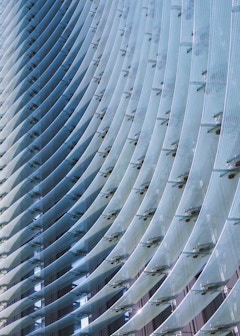
Simulation vs. reality: Insight and inspiration
Dr. Helen Sanders adds context to the Simulation vs. Reality dialogue.

Dr. Helen Sanders adds context to the Simulation vs. Reality dialogue.

The Simulation vs. Reality Forum proved to be the most popular yet hosted by FTI, in person or virtual, emphasizing the importance and sensitivity of this topic in our professional work and its impact on the built environment.

Hamid Vossoughi talks facade retrofits: the importance of and how to

Designing a multi-functional building envelope as an architectural façade, environmental interface and solar collector is a multi-objective
Few buildings are as iconic as Willis Tower. Generations have a collective memory of this building playing a role in their lives, but time had caught

The method proposed is derived from a parametric workflow that employs the precision of 6-axis robots and the flexibility of fabric to rapidly create

The Facade Tectonics Institute (FTI) announces upcoming changes to our staff and leadership team. On July 2, 2021, Katie Gould will leave her position as FTI’s Program Director to pursue other endeavors.

The 9th annual Building Innovation conference will take place September 27 – 29, 2021.

This month, our content is focused on how buildings impact people and their well-being. How does their shape, look, and design impact how we function? How are our daily lives, our culture, and our society influenced by the built environment around us?

IBPC 2021 unites researchers, practitioners, educators and students from the construction sector worldwide. The conference will be held online!

We invite members to submit nominations for a vacancy opening on our Board of Directors — we will consider applications for individuals working in material supplier, education, public interest, general contracting, building ownership/development, or fabrication spaces.

The Facade Tectonics Institute has extended the abstract submission deadline until July 13, 2021 for the 2022 World Congress (FTI WC2022).

FTI is now accepting nominations for the 2021 Vitruvian Honors & Awards and invites you to submit a project or project team for consideration. The deadline to submit is Monday, October 4, 2021. More details about the awards ceremony will be announced soon.

A’21 brings together leaders in architecture and beyond for a four-day, immersive digital experience that defines the year ahead. It’s the architecture and design event of the year!

CURRICULUM FOR CLIMATE AGENCY: DESIGN (IN)ACTION This year’s Teachers Conference will be held virtually from June 24 – 25, 2021. The virtual conference will be a forum for dialogue & debate on Curriculum for Climate Agency: Design (in)Action.

As Docomomo US celebrates its 25th anniversary, we are headed back to where it all began, Chicago, Illinois. It was in 1995 that a group of volunteers gathered during the first Preserving the Recent Past conference to set in motion a Docomomo chapter in the United States.

This conference explores and celebrates the very best in innovative tall buildings, urban spaces, building technologies, and construction practices from around the world. Incorporating what was previously known as the CTBUH Annual Awards Event, this conference will see the owner/developers and...

Rising complexity in project design and sustainability goals has catapulted digital tools to the forefront of the AEC industry.

Technoform recently embarked on a research project with the University of Massachusetts Amherst and are excited about the opportunity to collaborate with academia. We believe that building strong partnerships and networks that lead to shared results progresses the industry.


